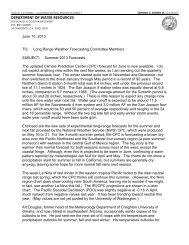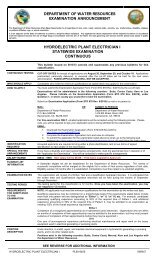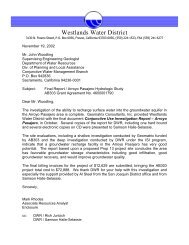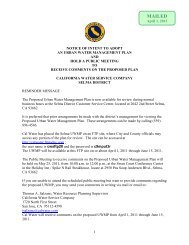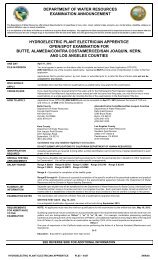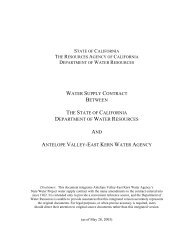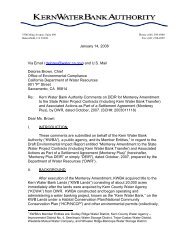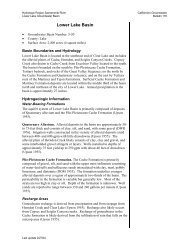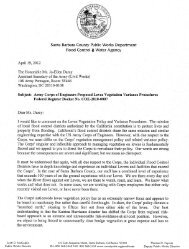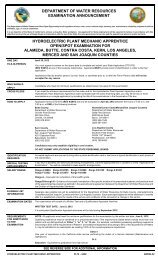Bulletin 1.pdf - California Department of Water Resources - State of ...
Bulletin 1.pdf - California Department of Water Resources - State of ...
Bulletin 1.pdf - California Department of Water Resources - State of ...
You also want an ePaper? Increase the reach of your titles
YUMPU automatically turns print PDFs into web optimized ePapers that Google loves.
48 WATER RESOURCES OF CALIFORNIA<br />
depth <strong>of</strong> precipitation were summed, to obtain mean weighted volume <strong>of</strong><br />
precipitation for all subareas and Areas <strong>of</strong> the <strong>State</strong>.<br />
RUNOFF<br />
Estimates <strong>of</strong> run<strong>of</strong>f given in this bulletin generally include only the<br />
portion <strong>of</strong> precipitation that 1I0ws from mountain and foothill lands. For<br />
the Sacramento Valley, however, run<strong>of</strong>f from precipitation on the valley<br />
lIoor also is included in estimated run<strong>of</strong>f.<br />
Run<strong>of</strong>f data previously published by the Division <strong>of</strong> <strong>Water</strong><br />
<strong>Resources</strong>, principally in <strong>Bulletin</strong>s Nos. 5, 26, and 29, have been extended<br />
or revised to conform to later information.<br />
The 53-year period from 1894-95 to 1946-47 was selected for determining<br />
mean seasonal run<strong>of</strong>f, in order to include dry years between 1894<br />
and 1904 in the southern part <strong>of</strong> the <strong>State</strong>. The period from 1894 to 1904<br />
was the driest <strong>of</strong>record in that region, whereas the driest period <strong>of</strong> record<br />
in the north was from 1923 to 1934.<br />
All estimates <strong>of</strong> run<strong>of</strong>f in this bulletin are for naturalllow as defined<br />
earlier in this chapter. In computing run<strong>of</strong>f data, measured run<strong>of</strong>f was<br />
adjusted to natural 1I0w by adding known upstream diversions and<br />
quantities stored in reservoirs, and subtracting importations and reservoir<br />
releases. Evaporation from reservoirs and lakes was also added to<br />
measured run<strong>of</strong>f where large enough to be significant. In the absence <strong>of</strong><br />
records at a reservoir or lake, evaporation was estimated from records at<br />
comparable locations. Where no records were available and water was<br />
known to have been stored, storage and release were estimated either<br />
from records <strong>of</strong> operation in other seasons, or from records <strong>of</strong> operation<br />
<strong>of</strong> other reservoirs in the same watershed, taking into account differences<br />
in run<strong>of</strong>f between seasons with available records and seasons for which<br />
estimates were made. The foregoing method <strong>of</strong> computing natural run<strong>of</strong>f<br />
was used only for periods for which records <strong>of</strong> measured run<strong>of</strong>f were<br />
available.<br />
One <strong>of</strong> the three methods described in the following paragraphs was<br />
used to estimate run<strong>of</strong>f for periods <strong>of</strong> incomplete records, although the<br />
first and second methods were used to only a limited extent.<br />
The first method involved use <strong>of</strong> the C Cindex <strong>of</strong> seasonal wetness,"<br />
which is defined as precipitation for the season expressed as a percentage<br />
<strong>of</strong> the long-time seasonal mean. In pursuing this method, indexes <strong>of</strong> wetness<br />
developed in Division <strong>of</strong> Engineering and Irrigation <strong>Bulletin</strong> No.5,<br />
"Flow in <strong>California</strong> Streams," were used. In this previous study the<br />
<strong>State</strong> was divided into 26 "precipitation divisions" and indexes <strong>of</strong> seasonal<br />
wetness were determined for each division. A c, curve <strong>of</strong> probable<br />
run<strong>of</strong>f" was then drawn for the stream being studied, by plotting run<strong>of</strong>f<br />
for seasons for which records were available against corresponding<br />
indexes <strong>of</strong> seasonal wetness. The curves were extended to give run<strong>of</strong>f for<br />
indexes as great as 200. Run<strong>of</strong>f for seasons lacking stream 1I0w records<br />
was then taken from the appropriate curve <strong>of</strong> indexes <strong>of</strong> seasonal wetness.<br />
In the second method, run<strong>of</strong>f for seasons <strong>of</strong> record was plotted<br />
against precipitation, and run<strong>of</strong>f for seasons lacking records was then<br />
taken from the curve. This method was followed where good coverage <strong>of</strong><br />
precipitation records was available over the drainage basin.



